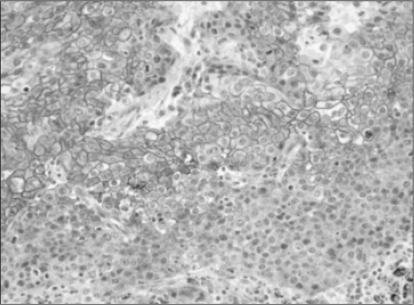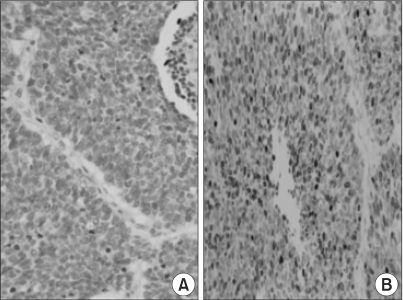Cancer Res Treat.
2004 Feb;36(1):56-61.
Reduced Expression of E-cadherin in Human Non-small Cell Lung Carcinoma
- Affiliations
-
- 1Department of Pathology, Dankook University College of Medicine, Chungnam, Korea.
Abstract
- PURPOSE
E-cadherin, a calcium-dependent cell to cell adhesion molecule, plays a key role in the maintenance of tissue integrity. Reduction or loss of E-cadherin has been reported to have a role in the development of human malignancies. The expression of E-cadherin was analyzed in human non-small cell lung carcinoma (NSCLC) to elucidate the role in pulmonary carcinogenesis and determine the relationship with several clinicopathological factors and the prognosis. MATERIALS AND METHODS: Sixty five human cases of NSCLC were evaluated by immunohistochemical analysis for the expression of E-cadherin. The immunostaining results for E-cadherin were semiquantitatively interpreted, as preserved and reduced, in the tumor tissues. The E-cadherin expression was analyzed in relation to several clinicopathological data and the survival. The cell proliferation index of the tumors was evaluated by immunostaining with the Ki-67 antigen. RESULTS: Reduced E-cadherin expression was found in 51 cases of NSCLC tissues (78.4%) compared to that in the normal controls. Reduced E-cadherin expression was significantly correlated with male smokers and squamous cell type of the cancer, but not with histological grade, TNM stage and survival. The E-cadherin expression showed a weak inverse relationship with the proliferative activity of tumor cells, which was measured using the Ki-67 antigen. CONCLUSION: Our data support the hypothesis that reduced E-cadherin expression may play a role in the pathogenesis of human NSCLC, which might be associated with the control for cell proliferation.
MeSH Terms
Figure
Reference
-
1. Smythe WR, Williams JP, Wheelock MJ, Johnson KR, Kaiser LR, Albelda SM. Cadherin and catenin expression in normal human bronchialepithelium and non-small cell lung cancer. Lung Cancer. 1999; 24:157–168. PMID: 10460003.2. Takeichi M. Cadherin cell adhesion receptors as a morphogenetic regulator. Science. 1991; 251:1451–1455. PMID: 2006419.
Article3. Takeichi M. Cadherins in cancer: implications for invasion and metastasis. Curr Opin Cell Biol. 1993; 5:806–811. PMID: 8240824.
Article4. Nakanishi Y, Ochiai A, Akimoto S, Kato H, Watanabe H, Tachimori Y, Yamamoto S, Hirohashi S. Expression of E-cadherin, α-catenin, β-catenin and plakoglobin in esophageal carcinomas and its prognostic significance: immunohistochemical analysis of 96 lesions. Oncology. 1997; 54:158–165. PMID: 9075789.5. Gabbert HE, Mueller W, Schneiders A, Meier S, Moll R, Birchmeier W, Hommel G. Prognostic value of E-cadherin expression in 413 gastric carcinomas. Int J Cancer. 1996; 69:184–189. PMID: 8682585.
Article6. Dorudi S, Hanby AM, Poulsom R, Northover J, Hart IR. Level of expression of E-cadherin mRNA in colorectal cancer correlates with clinical outcome. Br J Cancer. 1995; 71:614–616. PMID: 7880746.
Article7. Ihara A, Koizumi H, hashizume R, Uchikoshi T. Expression of epithelial cadherin and α- and β-catenin in nontumoral livers and hepatocellular carcinomas. Hepatology. 1996; 23:1441–1447. PMID: 8675162.8. Gunji N, Oda T, Todoroki T, Kanazawa N, Kawamoto T, Yuzawa K, Scarpa A, Fukao K. Pancreatic carcinoma: correlation between E-cadherin and α-catenin expression status and liver metastasis. Cancer (Phila.). 1998; 82:1649–1656. PMID: 9576284.9. Cheng L, Nagabhushan M, Pretlow TP, Amini SB, Pretlow TG. Expression of E-cadherin in primary and metastatic prostate cancer. Am J Pathol. 1996; 148:1375–1380. PMID: 8623909.10. Fei Q, Zhang H, Chen X, Wang J-C, Zhang R, Xu W, Zhang Z, Zou W, Zhang K, Qi Q, Wang M, Tao S, Luo Z. Defected expression of E-cadherin in non-small cell lung cancer. Lung Cancer. 2002; 37:147–152. PMID: 12140137.
Article11. Lee Y-C, Wu C-T, Chen C-S, Chang Y-L. E-cadherin expression in surgically-resected non-small cell lung cancers-A clinicopathological study. Thorac Cardiovasc Surg. 2000; 48:294–299. PMID: 11100763.12. Kase S, Sugio K, Yamazaki K, Okamoto T, Yano T, Sugimachi K. Expression of E-cadherin and β-catenin in human non-small cell lung cancer and the clinical significance. Clin Cancer Res. 2000; 6:4789–4796. PMID: 11156236.13. Lim S-C, Jang I-G, Kim Y-C, Park K-O. The role of E-cadherin expression in non-small cell lung cancer. J Korean Med Sci. 2000; 15:501–506. PMID: 11068984.
Article14. Liu D, Huang C-l, Kameyama K, Hayashi E, Yamauchi A, Koabyashi S, Yokomise H. E-cadherin expression associated with differentiation and prognosis in patients with non-small cell lung cancer. Ann Thorac Surg. 2001; 71:949–955. PMID: 11269479.
Article15. Sulzer MA, Leers MPG, van Noord JA, Bollen ECM, Theunissen PHMH. Reduced E-cadherin expression is associated with increased lymph node metastasis and unfavorable prognosis in non-small cell lung cancer. Am J Respir Crit Care Med. 1998; 157:1319–1323. PMID: 9563756.
Article16. Shibanuma H, Hirano T, Tsuji K, QingFang W, Shrestha B, Konaka C, Ebihara Y, Kato H. Influence of E-cadherin dysfunction upon local invasion and metastasis in non-small cell lung cancer. Lung Cancer. 1998; 22:85–95. PMID: 10022216.
Article17. Bohm M, Totzeck B, Wieland I. Differences of E-cadherin expression levels and patterns in human lung cancer. Ann Hematol. 1994; 68:81–83. PMID: 7511935.
Article18. Choi YS, Shim YM, Kim S-H, Son DS, Lee H-S, Kim GY, Han J, Kim J. Prognostic significance of E-cadherin and β-catenin in resected stage I non-small cell lung cancer. Eur J Cardiothorac Surg. 2003; 24:441–449. PMID: 12965318.19. Bohm M, Totzeck B, Birchmeier W, Wieland I. Differences of E-cadherin expression levels and patterns in primary and metastatic human lung cancer. Clin Exp Metastasis. 1994; 12:55–62. PMID: 8287621.20. Oh BR, Nah GJ, Kim SJ, Sim JH, Kwon DD, Park KS, Ryu SB, Park YI. The clinical usefulness of membranous E-cadherin in transitional cell carcinoma of the bladder. J Korean Cancer Assoc. 1998; 30:1219–1226.21. Han AC, Peralta-Soler A, Knudsen KA, Wheelock MJ, Johnson KR, Salazar H. Differential expression of N-cadherin in pleural mesotheliomas and E-cadherin in lung adenocarcinomas in formalin-fixed, paraffin-embedded tissues. Hum Pathol. 1997; 28:641–645. PMID: 9190996.
Article22. Nawrocki B, Polette M, Van Hengel J, Tournier J-M, Van Roy F, Birembaut P. Cytoplasmic redistribution of E-cadherin-catenin adhesion complex is associated with down-regulated tyrosine phosphorylation of E-cadherin in human bronchopulmonary carcinomas. Am J Pathol. 1998; 153:1521–1530. PMID: 9811344.
Article23. Morton RA, Ewing CM, Nagafuchi A, Tsukita S, Issacs WB. Recution of E-cadherin levels and deletion of the α-catenin gene in human prostate cancer cells. Cancer Res. 1993; 53:3585–3590. PMID: 8339265.24. Janowski JA, Newham PM, Kandemir O, Hirano M, Takeichi M, Pignatelli M. Differential expression of E-cadherin in normal, metaplastic and dysplastic oesophageal mucosa: a putative biomarker. Int J Oncol. 1993; 4:441–448.25. St Croix B, Sheehan C, Rak JW, Florenes VA, Slingerland JM, Kerbel RS. E-cadherin dependent growth suppression is mediated by the cyclin-dependent kinase inhibitor p27 (KIP1). J Cell Biol. 1998; 142:557–571. PMID: 9679152.
- Full Text Links
- Actions
-
Cited
- CITED
-
- Close
- Share
- Similar articles
-
- The role of E-cadherin expression in non-small cell lung cancer
- Expression of E-cadherin and a-catenin in Thyroid Carcinomas
- Prognostic Significance of E-cadherin Expression in Renal Cell Carcinoma
- Expression of e-cadherin with correlation to clinicopathologic parameters in oral squamous cell carcinoma
- Expression of E-Cadherin and beta-Catenin in Human Squamous Cell Carcinoma of the Tongue





